Native Son: April 2015
by Steven Chamblee
Discovering America in Columbus
What was I thinking? About six months ago, I accepted a late-March speaking invitation in Columbus, Texas, about 70 miles west of Houston. I had visions of slow-roading through miles of bluebonnets, their heady fragrance wafting on the wind. Visions of visiting nurseries and gardens along the way, taking photos of amazing sites and sharing it all with folks via e-gardens. What I forgot was the manic rush of getting Chandor Gardens up and ready for the season … like every spring. I forgot that my hands would be cracked, my back would be sacked, and brained would be wracked … like every spring. I also forgot how much I would need a little break from work this time of year, and a quick road trip south is like a massage for mind.

A peek inside the tree-production greenhouses at Rennerwood Nursery.
On the way down, I take a little 200-mile detour through Tennessee Colony to pick up 300 bur oak saplings to give away at Weatherford Blooms (April 25; on the square; y’all come!). Tennessee Colony is about the tiniest town you’ve ever seen, but it does have a gasso with a grill that makes you feel like you are in an old black and white Hollywood movie. It’s also home to Rennerwood Nursery, a wholesale-only grower of countless thousands of trees … and they use RootMaker® pots. These special pots are tiered and perforated, a unique design that produces non-circling, fibrous root systems on woody plants. (No, I don’t sell them; I just find this kind of stuff interesting.)
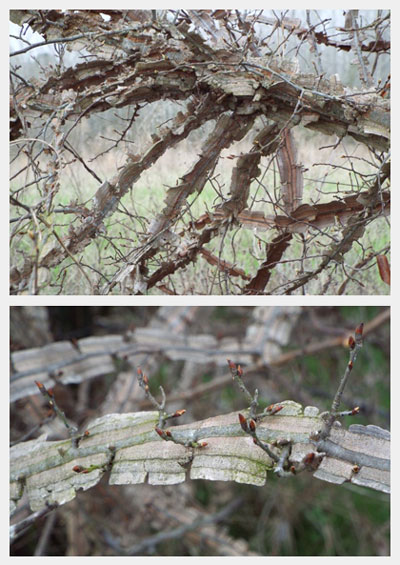
Winged elm (Ulmus alata) produces flattened growths called “corky wings.”
On the way back to the paved road, I encounter an amazing little fence-line tree. I assume it to be a winged elm (Ulmus alata) because of the exceptionally profuse display of corky wings covering the entire tree, though cedar elms (Ulmus crassifolia) often have corky-winged twigs as well. You can easily tell the difference between the two species by the leaves (winged elm has smooth leaves; cedar elm leaves are rough) and by the flowers (winged elm flowers in the spring; cedar elm in the fall). But since the branches are bare, I simply enjoy the tree for its quirky-corky beauty.
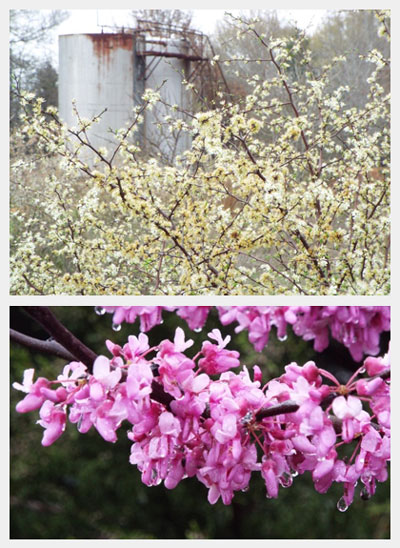
Early spring flowers of Mexican plum and redbud (Cercis canadensis).
Nearby, those popcorn blossoms of Mexican plum (Prunus mexicana) are keeping the honeybees entertained. I know there are other species of wild plums around here, but as far as I can figure, all of the others flower with the new-leaf expansion. Mexican plum flowers appear before the leaves.
I’m less than half a mile down little ol’ “highway” 675 when the bottom drops out of the sky and it starts raining. And who’s gonna complain about rain in a drought? I enjoy the roadside redbud trees on the way down, pausing for a photo or two and to munch a few buds (they’re edible) when the rain lets up a bit.
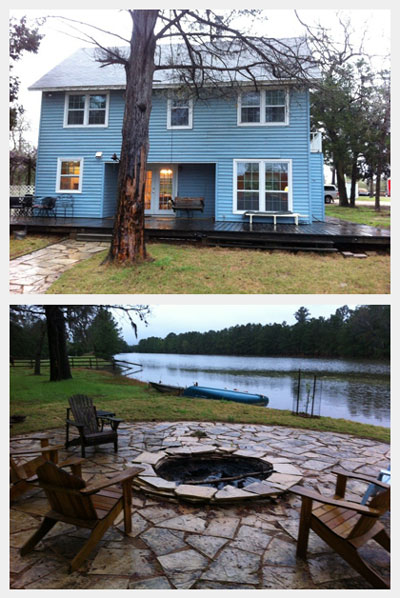
The Blue House B&B is comfort and relaxation inside and out.
The rain pounds away for hours, and I finally pull into town, where I am led down a long and winding road to a sah-weeeet little ol’ B&B, though I wouldn’t really call it little. “The Blue House” is two floors and three bedrooms of comfy quaint that I really can’t fully appreciate until morning light.
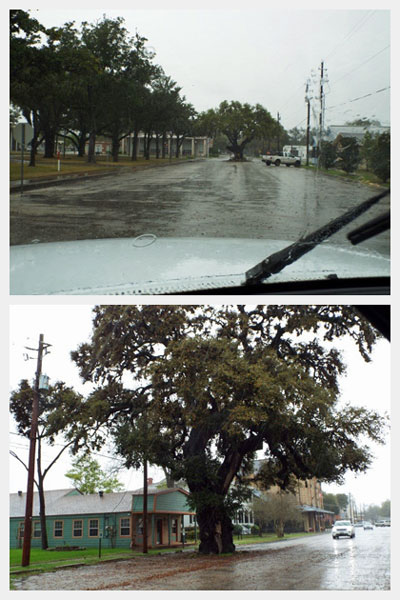
Automobiles share the streets with beloved live oak trees in Columbus.
All too soon, I’m heading back up the long and winding road (still raining) to give my presentation to a roomful of the nicest folks around — after which, one lady guides my truck around Columbus with hers, showing me the sights. First off is lovely courthouse square, a wonderful testament to people long-since passed who cared enough about the beautiful live oak trees to integrate them into the plan, even when it meant sharing the street with them. As we drive about town (still raining), I am amazed by the sheer number of large live oaks … it’s almost like they built a town under one big tree canopy.
American flags are flying everywhere, and it’s not any sort of holiday (though it might be in memory of when the town was burned by General Sam Houston in a defensive move against Santa Anna back in March of 1836). This small observation leads to my greater realization of the connection between the past and present citizens of Columbus … understanding sacrifice, reverence for Earth’s gifts, and deep appreciation for our freedoms. I have heard that the key to happiness is gratitude, and my eyes are seeing it unfold before me. This little town touches my heart, as it reminds me of the way, when I was a child, I thought our country was, and what it should be. I guess I still do.
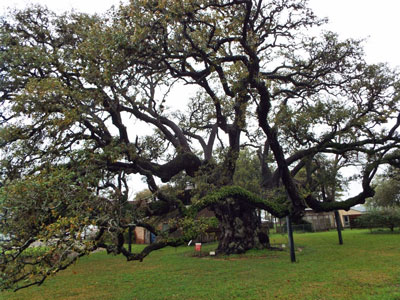
The third largest live oak in Texas –The Columbus Oak — is, in the author’s opinion, easily the most beautiful of the top three. (I don’t dislike the others; they are majestic as well. I just think this one is prettier.)
Just as I think the tour is about over, my guide pulls to the side of the road in front of me, and I literally gasp out loud when I first see it … The Columbus Oak. Exploding from the ground with branches spewing forth like rocket trails, this massive live oak soars some 70 feet high and billows out more than 110 feet wide. The colossal trunk is gnarled beyond belief — an 8-foot-thick sculptural column chunked with meaty burls and sliced with twisting fissures. I touch one of the limbs sheathed in resurrection fern (Pleopeltis polypodioides) and lichens, forming little epiphytic communities that thrive come drought or rain. Rain … I just now realize that it is indeed pouring rain, and I am soaked through and through … and I laugh out loud at my good fortune. To share this moment of rejuvenation, this moment of glory with one of Mother Nature’s most exquisite creations, is an ethereal gift. I lift my arms and eyes to the sky in victorious jubilation. An 18-wheeler honks his horn behind me and I come back to “reality” way too soon, recognizing that, to that trucker, I must look like an old fat guy trying to re-create the iconic scene in Shawshank Redemption. Who cares? I’m standing on sacred ground, breathing rare air, and I’ve got 280 miles of rain, green fields, and, yes, even bluebonnets ahead of me. And for all of that … every drop of that … I am truly grateful.
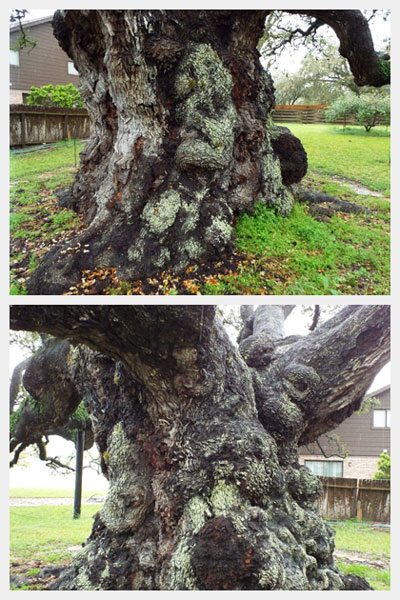
Two sides of the gargantuan trunk of The Columbus Oak.
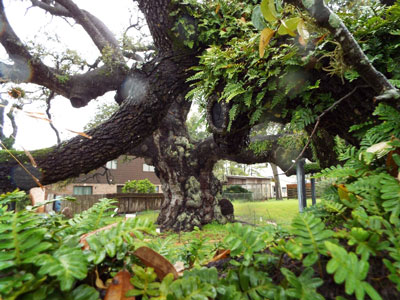
Resurrection ferns and lichens find an aerial home on The Columbus Oak.
Come out and breathe in the early spring beauty of Chandor Gardens! Go to www.chandorgardens.com for details. Just take I-20 west to exit 409, hang a right, go 2.1 miles and hang a left on Lee Avenue. Head straight 12 blocks and you’re driving in the gates. Call 817-361-1700 for more information.
I can always use another road trip! Let me know if you’d like me to come out and speak to your group sometime. I’m low-maintenance, flexible, and you know I like to go just about anywhere. No city too big; no town too small. Just send me an e-mail at stevenchamblee@yahoo.com and we’ll work something out.

